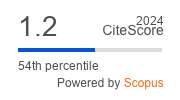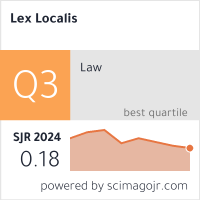Co-production and Citizens’ Satisfaction with Public Services: The Case of Environmental Public Services in China
DOI:
https://doi.org/10.4335/21.1.117-142(2023)Keywords:
citizens’ satisfaction, co-production, environmental public services, service-oriented governmentAbstract
This study investigates the impact of co-production on citizens’ satisfaction with environmental public services. Using survey data from China, the findings demonstrate that co-production can increase citizens’ satisfaction with environmental public services. Contrary to existing explanations, there is a significant difference between satisfaction with central and local governments in China. Co-production has positively increased citizens’ satisfaction with the effectiveness of environmental governance in local governments, and this has only partially positively increased for the central government. The findings demonstrate that co-production can optimize the structure of public services to increase citizens’ satisfaction with public services.
References
Alford, J. (1998) A public management road less travelled: Clients as co‐producers of public services, Australian Journal of Public Administration, 57(4), pp. 128-137, https://doi.org/10.1111/j.1467-8500.1998.tb01568.x.
Ariely, G. (2011) Why people (dis) like the public service: citizen perception of the public service and the NPM doctrine, Politics & Policy, 39(6), pp. 997-1019, https://doi.org/10.1111/j.1747-1346.2011.00329.x.
Brudney, J. L. & England, R. E. (1983) Toward a definition of the co-production concept, Public Administration Review, 43(1), pp. 59-65, https://doi.org/10.2307/975300.
Bouckaert, G., Van de Walle, S. & Kampen, J. K. (2005) Potential for comparative public opinion research in public administration, International Review of Administrative Sciences, 71(2), pp. 229-240, https://doi.org/10.2307/975300.
Bradbury, M. & Kellough, J. E. (2011) Representative bureaucracy: Assessing the evidence on active representation, The American Review of Public Administration, 41(2), pp. 157-167, https://doi.org/10.1177/0275074010367823.
Barrows, S., Henderson, M., Peterson, P. E. & West, M. R. (2016) Relative performance information and perceptions of public service quality: evidence from American school districts, Journal of Public Administration Research and Theory, 26(3), pp. 571-583, https://doi.org/10.1093/jopart/muw028.
Brandsen, T. & Honingh, M. (2016) Distinguishing different types of co-production: A conceptual analysis based on the classical definitions, Public Administration Review, 76(3), pp. 427-435, https://doi.org/10.1111/puar.12465.
Burgess, G. & Durrant, D. (2019) Reciprocity in the co-production of public services: the role of volunteering through community time exchange?, Social Policy and Society, 18(2), pp. 171-186, https://doi.org/10.1017/S1474746418000076.
Coulter, P. B. (1992) There’s a madness in the method: Redefining citizen contacting of government officials, Urban Affairs Quarterly, 28(2), pp. 297-316, https://doi.org/10.1177/004208169202800206.
Christensen, T. & Lægreid, P. (2005) Trust in government: The relative importance of service satisfaction, political factors, and demography, Public Performance & Management Review, 28(4), pp. 487-511, https:// 10.1080/15309576.2005.11051848.
Conway, B. P. & Hachen Jr., D. S. (2005) Attachments, grievances, resources, and efficacy: The determinants of tenant association participation among public housing tenants, Journal of Urban Affairs, 27(1), pp. 25-52, https://doi.org/10.1111/j.0735-2166.2005.00223.x.
Corburn, J. (2007) Community knowledge in environmental health science: co-producing policy expertise, Environmental Science & Policy, 10(2), pp. 150-161, https://doi.org/10.1111/j.0735-2166.2005.00223.x.
Carvalho, C. & Brito, C. (2012) Assessing users’ perceptions on how to improve public services quality, Public Management Review, 14(4), pp. 451-472, https://doi.org/10.1080/14719037.2011.649976.
Chen, S., Huang, J., Xiao, T., Gao, J., Bai, J., Luo, W. & Dong, B. (2020) Carbon emissions under different domestic waste treatment modes induced by garbage classification: case study in pilot communities in Shanghai, China, Science of The Total Environment, 717, https://doi.org/10.1016/j.scitotenv.2020.137193.
Cohen, N., Mizrahi, S. & Vigoda-Gadot, E. (2020) Alternative provision of public health care: the role of citizens’ satisfaction with public services and the social responsibility of government, Health Economics, Policy and Law, 17(2), pp. 121-140, https://doi.org/10.1017/S1744133120000201.
Cluley, V. & Radnor, Z. (2021) Rethinking co-creation: The fluid and relational process of value co-creation in public service organizations, Public Money & Management, 41(7), pp. 563-572, https://doi.org/10.1080/09540962.2020.1719672.
Dabija, D. C., Băbuţ, R. & Pop, C. M. (2013) A customer-oriented approach to satisfaction with public service providers: Empirical findings from a market undergoing liberalization, Transylvanian Review of Administrative Sciences, 9(SI), pp. 26-49, available at: http://rtsa.ro/tras/ (January 22, 2022).
Dahlström, C., Nistotskaya, M. & Tyrberg, M. (2018) Outsourcing, bureaucratic personnel quality and citizen satisfaction with public services, Public Administration, 96(1), pp. 218-233, https://doi.org/10.1111/padm.12387.
Engen, M., Fransson, M., Quist, J. & Skålén, P. (2021) Continuing the development of the public service logic: a study of value co-destruction in public services, Public Management Review, 23(6), pp. 886-905, https://doi.org/10.1080/14719037.2020.1720354.
Ferrari, P. A. & Manzi, G. (2014) Citizens evaluate public services: A critical overview of statistical methods for analysing user satisfaction, Journal of Economic Policy Reform, 17(3), pp. 236-252, https://doi.org/10.1080/17487870.2014.909313.
Fledderus, J. (2015) Does user co-production of public service delivery increase satisfaction and trust? Evidence from a vignette experiment, International Journal of Public Administration, 38(9), pp. 642-653, https://doi.org/10.1080/01900692.2014.952825.
Frinaldi, A. & Embi, M. A. (2015) Influence of public service quality in citizen satisfaction (study in private hospital Y in Padang, West Sumatra Province), Journal of Government and Politics, 6(1), pp. 88-101, https://doi.org/10.18196/jgp.2015.0008.
French, M., Popal, A., Rahimi, H., Popuri, S. & Turkstra, J. (2019) Institutionalizing participatory slum upgrading: a case study of urban co-production from Afghanistan, 2002–2016, Environment and Urbanization, 31(1), pp. 209-230, https://doi.org/10.1177/0956247818791043.
Grolnick, W. S. & Slowiaczek, M. L. (1994) Parents’ involvement in children's schooling: A multidimensional conceptualization and motivational model, Child Development, 65(1), pp. 237-252, https://doi.org/10.1111/j.1467-8624.1994.tb00747.x.
Gavrielides, T. (2008) Human rights and customer satisfaction with public services: a relationship discovered, The International Journal of Human Rights, 12(2), pp. 189-204, https://doi.org/10.1080/13642980801899634.
Guenoun, M., Goudarzi, K. & Chandon, J. L. (2016) Construction and validation of a hybrid model to measure perceived public service quality (PSQ), International Review of Administrative Sciences, 82(1), pp. 208-230, https://doi.org/10.1177/0020852315570551.
Hill, K. Q. & Hinton-Anderson, A. (1995) Pathways of representation: A causal analysis of public opinion-policy linkages, American Journal of Political Science, 39(4), pp. 924-935, https://doi.org/10.2307/2111663.
Hirlinger, M. W. (1992) Citizen-initiated contacting of local government officials: a multivariate explanation, The Journal of Politics, 54(2), pp. 553-564, https://doi.org/10.2307/2132039.
Hu, R. (2007) Rural petitioners and the loss of political trust, Sociological Studies, 129(3), pp. 39-55, https://doi.org/ 10.19934/j.cnki.shxyj.2007.03.003.
Hu, S., Zeng, R. & Yi, C. (2019) Media use and environmental public service satisfaction—an empirical analysis based on China, Sustainability, 11(14), https://doi.org/10.3390/su11143873.
He, A. J. & Ma, L. (2021) Citizen participation, perceived public service performance, and trust in government: Evidence from health policy reforms in Hong Kong, Public Performance & Management Review, 44(3), pp. 471-493, https://doi.org/10.1080/15309576.2020.1780138.
Jhandir, S. U. (2012) Customer satisfaction, perceived service quality and mediating role of perceived value, International Journal of Marketing Studies, 4(1), pp. 68-76, available at: https://mpra.ub.uni-muenchen.de/id/eprint/54733 (February 26, 2022).
Knight, J. & Shi, L. (1996) Educational attainment and the rural‐urban divide in China, Oxford Bulletin of Economics and Statistics, 58(1), pp. 83-117, https://doi.org/10.1111/j.1468-0084.1996.mp58001005.x.
Kampen, J. K., De Walle, S. V. & Bouckaert, G. (2006) Assessing the relation between satisfaction with public service delivery and trust in Government: The impact of the predisposition of citizens toward Government on evalutations of its performance, Public Performance & Management Review, 29(4), pp. 387-404, https://doi.org/10.1080/15309576.2006.11051881.
Knutsen, C. H. & Rasmussen, M. (2018) The autocratic welfare state: old-age pensions, credible commitments, and regime survival, Comparative Political Studies, 51(5), pp. 659-695, https://doi.org/10.1177/0010414017710265.
Lelieveldt, H., Dekker, K., Völker, B. & Torenvlied, R. (2009) Civic organizations as political actors: Mapping and predicting the involvement of civic organizations in neighborhood problem-solving and coproduction, Urban Affairs Review, 45(1), pp. 3-24, https://doi.org/10.1177/1078087409332303.
Lin, T. (2013) Explaining citizens’ satisfaction with public service quality in Chinese cities 2010: citizen-level predictors vs. City-level predictors, In: Wu, W. (ed.) Building Service-oriented Government: Lessons, Challenges and Prospects (Singapore: World Scientific Publishers), pp. 145-162.
Liu, H. & Raine, J. W. (2016) Why is there less public trust in local government than in central government in China?, International Journal of Public Administration, 39(4), pp. 258-269, https://doi.org/10.1080/01900692.2015.1004090.
Li, L. (2016) Reassessing trust in the central government: Evidence from five national surveys, The China Quarterly, 225, pp. 100-121, https://doi.org/10.1017/S0305741015001629.
Li, B. & Mayraz, G. (2017) Infrastructure spending in China increases trust in local government, Social Indicators Research, 132(1), pp. 341-356, https://doi.org/10.1007/s11205-015-1223-z.
Lindenmeier, J., Seemann, A. K., Potluka, O. & von Schnurbein, G. (2021) Co-production as a driver of client satisfaction with public service organizations: an analysis of German day-care centers, Public Management Review, 23(2), pp. 210-232, https://doi.org/10.1080/14719037.2019.1674366.
Meier, K. J. (1975) Representative bureaucracy: An empirical analysis, American Political Science Review, 69(2), pp. 526-542, https://doi.org/10.2307/1959084.
Meijer, A. J. (2011) Networked coproduction of public services in virtual communities: From a government‐centric to a community approach to public service support, Public Administration Review, 71(4), pp. 598-607, https://doi.org/10.1111/j.1540-6210.2011.02391.x.
Matei, L., Matei, A. & Lazar, C. G. (2016) Public service performance and good administration. Socio economic empirical evaluations, Procedia Economics and Finance, 39, pp. 335-338, https://doi.org/10.1016/S2212-5671(16)30332-X.
Ma, L. & Christensen, T. (2019) Government trust, social trust, and citizens’ risk concerns: Evidence from crisis management in China, Public Performance & Management Review, 42(2), pp. 383-404, https://doi.org/10.1080/15309576.2018.1464478.
Nabatchi, T., Sancino, A. & Sicilia, M. (2017) Varieties of participation in public services: The who, when, and what of coproduction, Public Administration Review, 77(5), pp. 766-776, https://doi.org/10.1111/puar.12765.
Ostrom, E. (1996) Crossing the great divide: Coproduction, synergy, and development, World Development, 24(6), pp. 1073-1087, https://doi.org/10.1016/0305-750X(96)00023-X.
O’Toole Jr., L. J. & Meier, K. J. (2003) Plus ça change: Public management, personnel stability, and organizational performance, Journal of Public Administration Research and Theory, 13(1), pp. 43-64, https://doi.org/10.1093/jopart/mug009.
Osborne, S. P. & Strokosch, K. (2013) It takes two to tango? understanding the co-production of public services by integrating the services management and public administration perspectives, British Journal of Management, 24(S1), pp. S31-S47, https://doi.org/10.1111/1467-8551.12010.
Osborne, S. P., Radnor, Z. & Nasi, G. (2013) A new theory for public service management? Toward a (public) service-dominant approach, The American Review of Public Administration, 43(2), pp. 135-158, https://doi.org/10.1177/0275074012466935.
Osborne, S. P. & Strokosch, K. (2013) It takes Two to Tango? Understanding the C o‐production of Public Services by Integrating the Services Management and Public Administration Perspectives, British Journal of Management, 24(S1), pp. S31-S47, https://doi.org/10.1111/1467-8551.12010.
Osborne, S. P., Radnor, Z., Kinder, T. & Vidal, I. (2015) The service framework: a public‐service‐dominant approach to sustainable public services, British Journal of Management, 26(3), pp. 424-438, https://doi.org/10.1111/1467-8551.12094.
Osborne, S. P., Radnor, Z. & Strokosch, K. (2016) Coproduction and the cocreation of value in public services: a suitable case for treatment, Public Management Review, 18(5), pp. 639-653, https://doi.org/10.1080/14719037.2015.1111927.
Osborne, S. P. (2018) From public service-dominant logic to public service logic: are public service organizations capable of co-production and value co-creation?, Public Management Review, 20(2), pp. 225-231, https://doi.org/10.1080/14719037.2017.1350461.
Oliver, K., Kothari, A. & Mays, N. (2019) The dark side of coproduction: do the costs outweigh the benefits for health research?, Health Research Policy and Systems, 17(1), pp. 1-10, https://doi.org/10.1186/s12961-019-0432-3.
Pestoff, V. (2006) Citizens and co-production of welfare services: childcare in eight European countries, Public Management Review, 8(4), pp. 503-519, https://doi.org/10.1080/14719030601022882.
Paarlberg, L. E. & Gen, S. (2009) Exploring the determinants of nonprofit coproduction of public service delivery: The case of K-12 public education, The American Review of Public Administration, 39(4), pp. 391-408, https://doi.org/10.1177/0275074008320711.
Pollitt, C. (2009) Public service quality—between everything and nothing?, International Review of Administrative Sciences, 75(3), pp. 379-382, https://doi.org/10.1177/0020852309341932.
Palumbo, R. & Manna, R. (2018) What if things go wrong in co-producing health services? Exploring the implementation problems of health care co-production, Policy and Society, 37(3), pp. 368-385, https://doi.org/10.1080/14494035.2018.1411872.
Roch, C. H. & Poister, T. H. (2006) Citizens, accountability, and service satisfaction: The influence of expectations, Urban Affairs Review, 41(3), pp. 292-308, https://doi.org/10.1177/1078087405281124.
Sharp, E. B. (1980) Toward a new understanding of urban services and citizen participation: The coproduction concept, Midwest Review of Public Administration, 14(2), pp. 105-118, https://doi.org/10.1177/027507408001400203.
Surva, L., Tõnurist, P. & Lember, V. (2016) Co-production in a network setting: providing an alternative to the national probation service, International Journal of Public Administration, 39(13), pp. 1031-1043, https://doi.org/10.1080/01900692.2016.1193752.
Song, M. & Meier, K. J. (2018) Citizen satisfaction and the kaleidoscope of government performance: How multiple stakeholders see government performance, Journal of Public Administration Research and Theory, 28(4), pp. 489-505, https://doi.org/10.1093/jopart/muy006.
Shi, C., Shi, Q. & Guo, F. (2019) Environmental slogans and action: The rhetoric of local government work reports in China, Journal of Cleaner Production, 238, https://doi.org/10.1016/j.jclepro.2019.117886.
Song, M., An, S. H. & Meier, K. J. (2021) Quality standards, implementation autonomy, and citizen satisfaction with public services: cross-national evidence, Public Management Review, 23(6), pp. 906-928, https://doi.org/10.1080/14719037.2020.1730939.
Thomas, J. C. & Melkers, J. E. (2001) Citizen contacting of municipal officials: choosing between appointed administrators and elected leaders, Journal of Public Administration Research and Theory, 11(1), pp. 51-72, https://doi.org/10.1093/oxfordjournals.jpart.a003494.
Uzochukwu, K. & Thomas, J. C. (2018) Who engages in the coproduction of local public services and why? The case of Atlanta, Georgia, Public Administration Review, 78(4), pp. 514-526, https://doi.org/10.1111/puar.12893.
Van de Walle, S. & Van Ryzin, G. G. (2011) The order of questions in a survey on citizen satisfaction with public services: Lessons from a split‐ballot experiment, Public Administration, 89(4), pp. 1436-1450, https://doi.org/10.1111/j.1467-9299.2011.01922.x.
Verschuere, B., Brandsen, T. & Pestoff, V. (2012) Co-production: The state of the art in research and the future agenda, VOLUNTAS: International Journal of Voluntary and Nonprofit Organizations, 23(4), pp. 1083-1101, https://doi.org/10.1007/s11266-012-9307-8.
Voorberg, W. H., Bekkers, V. J. & Tummers, L. G. (2015) A systematic review of co-creation and co-production: Embarking on the social innovation journey, Public Management Review, 17(9), pp. 1333-1357, https://doi.org/10.1080/14719037.2014.930505.
Van Ryzin, G. G. (2015) Service quality, administrative process, and citizens’ evaluation of local government in the US, Public Management Review, 17(3), pp. 425-442, https://doi.org/10.1080/14719037.2013.841456.
Van Eijk, C. & Steen, T. (2016) Why engage in co-production of public services? mixing theory and empirical evidence, International Review of Administrative Sciences, 82(1), pp. 28-46, https://doi.org/10.1177/0020852314566007.
Whitaker, G. P. (1980) Coproduction: Citizen participation in service delivery, Public Administration Review, 40(3), pp. 240-246, https://doi.org/10.2307/975377.
Williams, B. N., Kang, S. C. & Johnson, J. (2016) (Co)-contamination as the dark side of co-production: Public value failures in co-production processes, Public Management Review, 18(5), pp. 692-717, https://doi.org/10.1080/14719037.2015.1111660.
Walle, S. V. D., Kampen, J. K. & Bouckaert, G. (2005) Deep impact for high-impact agencies? Assessing the role of bureaucratic encounters in evaluations of government, Public Performance & Management Review, 28(4), pp. 532-549, https://doi.org/10.1080/15309576.2005.11051846.
Yang, Y. (2018) Is transparency a double-edged sword in citizen satisfaction with public service? Evidence from China’s public healthcare, Journal of Service Theory and Practice, 28(4), pp. 484-506, https://doi.org/10.1108/JSTP-06-2017-0102.
Yang, C. & Northcott, D. (2019) Together we measure: Improving public service outcomes via the co-production of performance measurement, Public Money & Management, 39(4), pp. 253-261, https://doi.org/10.1080/09540962.2019.1592906.
Yang, W. & Shen, X. (2021) Can social welfare buy mass loyalty?, Governance, 34(4), pp. 1213-1233, https://doi.org/10.1111/gove.12553.
Zhong, Y. (2014) Do Chinese people trust their local government, and why? An empirical study of political trust in urban China, Problems of Post-Communism, 61(3), pp. 31-44. https://doi.org/10.2753/PPC1075-8216610303.
Zhao, D. & Hu, W. (2017) Determinants of public trust in government: Empirical evidence from urban China, International Review of Administrative Sciences, 83(2), pp. 358-377, https://doi.org/10.1177/0020852315582136.
Zhang, Y., Liu, X. & Vedlitz, A. (2020) Issue-specific knowledge and willingness to coproduce: the case of public security services, Public Management Review, 22(10), pp. 1464-1488, https://doi.org/10.1080/14719037.2019.1635193.








